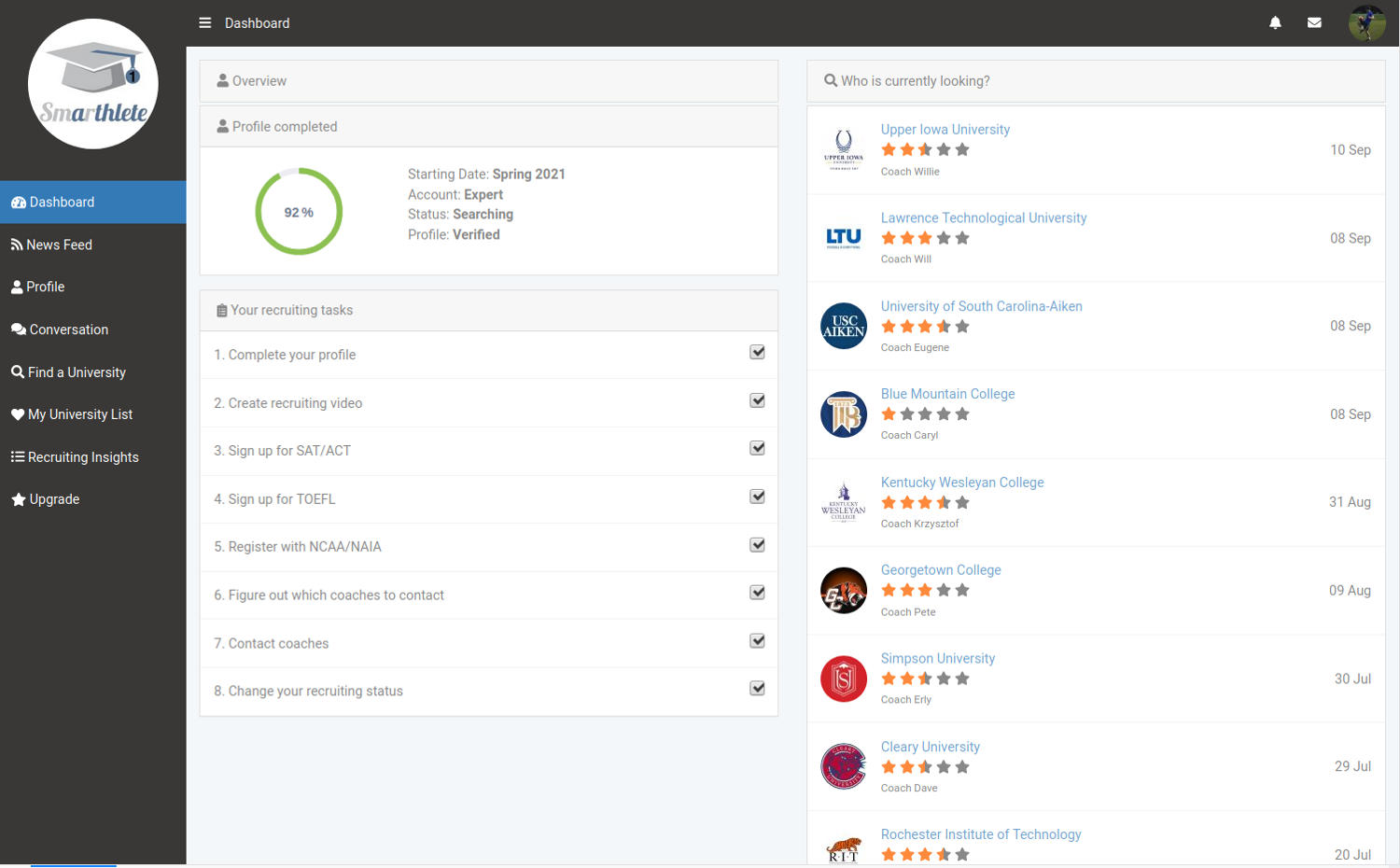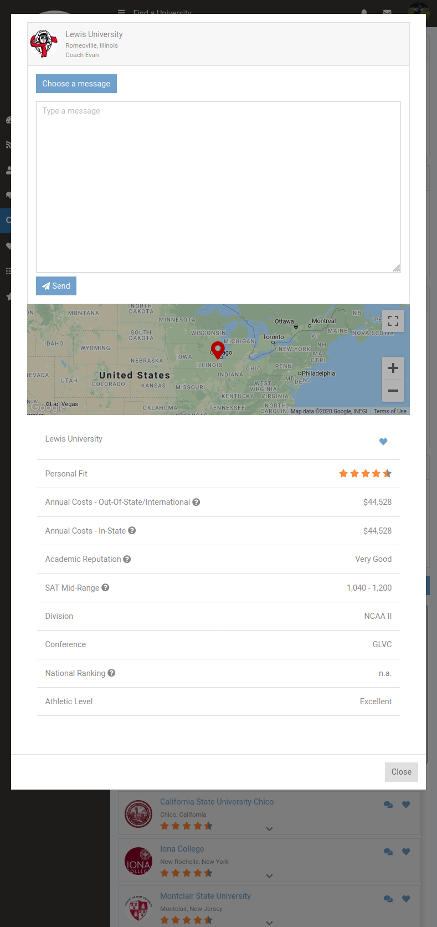Afford going to college
Once you understand the various types of funding available to students and student athletes (see Scholarship Types), it's time to put all of the information together in order to figure out how you can afford going to your dream school in the future.
First things first, which costs are actually covered by an institutional scholarship? Or put differently: what kind of costs am I looking at when applying to a university?
It's a bit of a jungle out there with every school presenting expected costs in a slightly different way. Annoyingly enough, there are even schools working with outdated numbers, such as total cost of attendance for the academic year 2016-17, which is not very helpful when doing your research.
Total cost of attendance and the various types of costs included in any school's financial breakdown is the starting point.


Get Scholarship Offers
Research the right programs for you (ahletics, academics, cost of attendance) by using your Personal Fit & contact coaches through Smarthlete.
Total cost of attendance
Any school in the U.S. has a section on their website on the costs of studying. While some of the costs presented are direct costs (tuition & fees, room & board, books & materials), some of the costs are indirect costs (insurance, transportation expenses, personal expenses). The purpose of listing all these types of costs is for you to better understand what it's going to cost you to attend the university for 4 full years.
Tuition & Fees
"Tuition" is the cost of studying full-time in an academic year. Often, this is an “all-in package” with a price tag for the first year. But it might also be calculated per credit hours taken. The range of tuition costs is huge with some of the most renowned schools charging a tuition easily three times the price of other schools. As a rule of thumb, tuition at state schools is lower than at private schools.
"Fees" is somewhat of an annoying and controversial topic, as there is no clear structure all schools follow and families may end up in surprise, once they take a look at the student balance with all the various fees added. Colleges end up being very creative and (may) charge fees for a lot of different things, such as “Student Health Services Fee”, “Technology Fee”, “Lab Fee”, “Orientation Fee”, “Campus Fee”, “Environment Fee”, “Tech Fee” or “Athletic Fee”. It usually says all that in the fine print on the university website(s) or in the financial breakdown for the upcoming academic years. However, there is a different approach some schools have been moving towards, such as the University of the Cumberlands, which offers one figure for tuition and fees, including all costs for its students.
Don't be turned off solely by a higher cost of attendance. You don't know the amount of financial aid schools are prepared to offer to student athletes like you, based on your merits (academically and athletically) and need-based.
Tuition costs are usually subject to increases over time and you should be aware of that. You can also review the historical price increases of the various schools, which gives you a better idea of how costs may develop going forward. An increase of 1-5% per year is typically a realistic assumption.
Some schools offer a "tuition freeze" or "fixed tuition". Say, you start your degree in 2022-2023 with tuition sitting at 50,000 USD, your tuition will remain at 50,000 USD for the remaining three years of your degree in 2023-2024, 2024-2025 and 2025-2026. A school, which has set-up its tuition structure this way is the University of the Sciences for example.
Room & Board
The vast majority of universities requires all incoming freshmen to live on-campus. Some schools even require students to continue living on campus during sophomore year or even longer, but as a rule of thumb freshman year on campus it is.
Starting your college life on campus is truly great because you really arrive in your new home, get to meet tons of new people and make friendships for life. However, you also pay for the experience and it's often quite a large expense, compared to living off-campus.
Depending on school, there are a number of different housing options available. Dorm rooms, such as single, double, triple or quadruple rooms and apartment-style housing. Some schools have designated underclassmen (freshmen & sophomores) and upperclassmen (juniors, seniors) housing facilities available, with other schools offering different room rates depending on what you are looking for (shared or private bathroom, etc.).
"Board" covers your food expenses and is typically available in the form of different meal plans, such as 12 meals/week, 15 meals/week, 19 meals/week or “unlimited meal plan”. You sometimes also receive a set amount of money on your student card, which you can spend as you wish in the school's cafeteria(s).
Often, schools offer a room rate for the full academic year, which has cheaper and more expensive rooms to choose from. The same goes for the meal plan, with fewer meals obviously costing less.
Pick as you like, but make sure you understand what is included.
Because the requirement of living on-campus may end after your freshman year, you should take into consideration to move off-campus after your freshman, sophomore, or junior year. While it's hard to estimate exactly how much money you'd end up saving by sharing an apartment or house with your peers or team colleagues and cooking for yourselves, it's a conversation you should have with the coaches recruiting you, as they often have a very good idea, based on their current student athletes' housing set-up. It's not unusual that athletes' apartments/houses are passed on within the team, meaning when a senior moves out another sophomore may move in, which is nice set-up for everybody involved.
Moving off-campus is often – but not always – cheaper, as it depends on the location of the university. Some areas simply see much higher costs of living (rent) than others. For example, a shared apartment in California is going to cost you a fair bit more than a similar place in a small town in North Carolina. Also, some areas may have more housing options available for students' budgets than others.
On-campus room & board costs are also subject to increase over time.
Books & Materials
This figure is displayed in the total cost of attendance as well and may sit somewhere between 500 and 2,500 USD. Books are expensive, especially if bought newly.
"Draw up a financial projection for the 4 years in college based on the scholarship offer received. Allow room for flexibility (moving off-campus, etc.), but account for potential price increases."
Insurance
Most schools have specific requirements or recommendations, which insurance plans students should purchase. Prices vary a lot due to different levels of deductibles, co-insurance, coverage, and benefits.
While there is no right or wrong, the most important thing to keep in mind for you is for intercollegiate injuries to be included. Coaches and athletic departments are typically involved in making sure you have the right coverage in place. In case you have any questions, ask the school recruiting you for assistance (and/or your recruiting service).
In case you have an existing health insurance in place, you don't need to purchase the insurance required/recommend by the university, as long as you can show proof that your coverage is sufficient.
For international students this is often a confusing and complex topic, as documents would need to get translated and it might just be the easiest – and safest – to get (additional) insurance in the U.S.
Optional: Transportation
Transportation expenses are sometimes listed as part of the total costs of attendance, but it will likely never be exactly what you're going to spend. Travelling to the East Coast twice a year from Florida will carry a different price tag than travelling from Oregon. Flying over from Asia will be more expensive than taking your own car for a couple hours.
Optional: Personal expenses
The same goes for your personal expenses. A college doesn't know what you're going to want to spend on food, entertainment, travelling, doing fun stuff with your friends, but it's an estimate they provide to give you an idea.
You should definitely do your own projection with your parents, as they may also be the ones providing you with the monthly pocket money for personal expenses to some extent.
Your remaining costs to pay for college
You should carefully consider how much money you are prepared to invest in your future education.
- What can you afford/year?
- How much money can your parents contribute?
- How good a school do you want to attend and is it worth spending a little extra for the reputation of the school and the degree you'll earn?
The answers you and your family will arrive at will greatly impact your college search going forward, as you have to make sure you target the right schools; the ones which meet your budget after receiving financial aid.
Be prepared to speak all things budget to the school/coach recruiting you. Chances are you will be asked: “What's your budget?
Depending on the coach, you will receive a scholarship offer which may be a figure only (say, an athletic scholarship of 40,000 USD) or a full financial breakdown which starts out with the total cost of attendance followed by the full scholarship amount that you are being offered.
No matter how you end up receiving your scholarship offer, you will know what it would cost you to accept the offer from a school for the first year and for the years thereafter (if you were to live-on-campus).
Factor in that some sports follow a recruiting model, which sees recruits receiving less scholarship money in year 1 and 2, before getting a little more money in their junior and senior years. It's a model which lets coaches assess you over a longer period of time, wanting you to proof yourself first, before making a larger investment in you.
Work-study opportunities
Working-on-campus or working in some other student jobs close to your school is a smart way of helping pay for college. Make no mistake, your earnings potential is limited, as you need to balance your time with school work and athletic commitments, but working a few hours here and there is possible of course.
There is a limit on the potential hours you could be working on campus, due to student positions available but if that is an interesting option for you, you should get in contact with the people responsible once you arrive on campus.
Next Read
Read up on academic tests, such as SAT or ACT and know what you need to do in order to do well and secure yourself great academic scholarship offers.